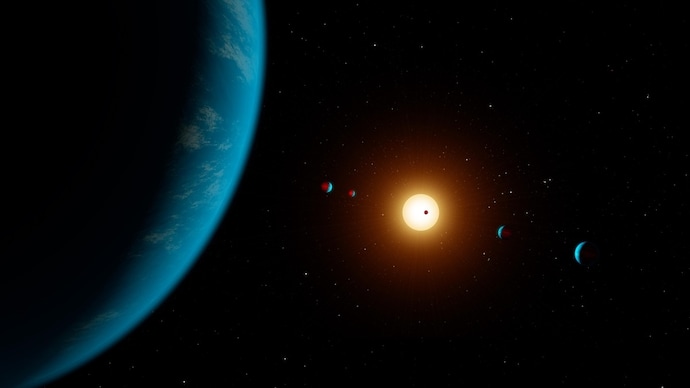In a groundbreaking discovery that could revolutionize our understanding of planetary systems, astronomers have identified a captivating ensemble of six sub-Neptune planets orbiting in a rare synchronised dance around a distant star, HD110067, located approximately 100 light-years away in the constellation Coma Berenices.
These newfound planets, ranging from 1.9 to 2.9 times the diameter of Earth but smaller than Neptune, challenge our current planetary models as they deviate significantly from the composition and characteristics of our own solar system’s planets.
The detection of these six intriguing planets was achieved through intricate observations. As each planet transited, or passed in front of, the star from our perspective on Earth, it caused a slight dimming in the star’s brightness, revealing its existence.
What makes this discovery particularly captivating is the orbital resonance of these planets, meaning their orbits are perfectly aligned, maintaining a stable relationship for an astonishing 4 billion years. This stability suggests that these planets have remained undisturbed by any major cataclysmic events since their formation.
“The resonance aspect is really interesting – partly the mathematical beauty of it,” remarked Hugh Osborn, an astronomer at the University of Bern and co-author of the study published in the journal Nature. “These are definitely not Earth-like planets.”
Sub-Neptunes, the most prevalent type of planet in our galaxy, continue to perplex astronomers due to their enigmatic nature. They could be rocky worlds cloaked in thick atmospheres of hydrogen and helium gas, or perhaps composed of rock and ice encased in warm, water-rich atmospheres.
The newly discovered sub-Neptunes, though intriguing, don’t reside within the traditional habitable zone – the region around a star where conditions might be ideal for liquid water and the potential for life. However, their substantial atmospheres could influence their surface temperatures, potentially expanding the habitable zone for such planets.
Rafael Luque, lead author of the study and an astronomer at the University of Chicago, highlighted the significance of the James Webb Space Telescope (JWST) in furthering our understanding of these planets. “The potential habitability of sub-Neptunes is an active topic of research in the field, and promising results are expected on this front coming from JWST, likely of this very planetary system,” he stated.
This groundbreaking discovery not only adds to our ever-expanding catalog of exoplanets but also presents a unique opportunity to investigate the atmospheric composition and potential habitability of worlds unlike any found in our solar system. With the aid of JWST, scientists aspire to delve deeper into the mysteries of sub-Neptunes and perhaps inch closer to answering the age-old question: Is Earth alone in the universe?
